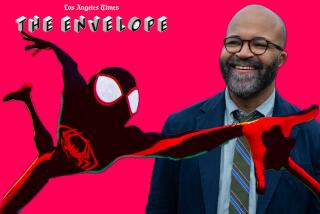John Knowles, 75; Wrote ‘A Separate Peace’
Novelist John Knowles, whose 1960 book “A Separate Peace” became a modern classic for its sensitive evocation of adolescent conflict, died Thursday after a short illness at a convalescent home near Fort Lauderdale, Fla. He was 75.
Knowles’ first and best-known work was based on his experiences at Phillips Exeter Academy, a well-known New Hampshire boarding school. Although he wrote eight other novels, none received the acclaim he earned with his debut work, which received the William Faulkner Foundation Prize and inspired a 1973 movie.
He did not seem bitter about the shadow “A Separate Peace” cast over his other novels, which include “Indian Summer” (1966) and “Peace Breaks Out” (1981). His avowedly autobiographical debut novel, he often acknowledged, made him famous and gave him financial security.
Decades after its original publication, “Separate Peace” was selling half a million copies a year and remains a staple of high school and college reading lists.
“Isn’t that incredible?” he said in 1986. “And what touches me most, what pleases me most, is that people who are far removed from the world of prep schools love it.”
One of the characters, Brinker, was based on Gore Vidal, who was a few years ahead of Knowles at Exeter in the mid-1940s. The two writers eventually became good friends.
“I have no memory of him when we were in school together,” Vidal said Thursday from his home in Italy. “The next thing I know is he has published ‘A Separate Peace,’ in which I play a cameo part as sort of a snoop. . . . Then I got to know him, because I thought ‘A Separate Peace’ was a marvelous book. It was beyond anything he ever did later and anyone else had done of that sort, with the possible exception of [J.D. Salinger’s] ‘Catcher in the Rye.’ ”
When Knowles made his literary debut, one reviewer eagerly asked: “Is he the successor to Salinger for whom we have been waiting for so long?”
The parallels to Salinger’s masterpiece, published a decade earlier, in 1951, were hard to ignore. Both dealt with the angst of prep school boys, and both were highly praised first novels.
Knowles was born in Fairmont, W. Va., where his father was in the coal business. His parents expected him to follow his older brother to a prep school in Pennsylvania, but Knowles--”just for the hell of it”--applied to Exeter. He cannily chose “Jane Eyre” as the topic of his essay for the school’s English entrance exam and later reflected that the essay must have been good because his math and Latin scores were abysmal.
Encouraged to Write by Thornton Wilder
Entering Exeter in fall 1942, Knowles was an indifferent student at first, more concerned with getting by than getting ahead.
He graduated in 1945 and joined the war effort as part of the Army Air Force’s Aviation Cadet Program. Several months later, he entered Yale University, earning a bachelor’s degree in 1949.
In the 1950s, Knowles spent much of his time as a journalist, first as a freelancer in Europe and later as an associate editor of Holiday magazine.
He became friends with playwright Thornton Wilder, who encouraged him to write. Knowles began to work on “A Separate Peace,” quitting journalism after its successful publication.
He drew heavily on his Exeter years because they were, he once said, “more crucial in my life than in the lives of most members of my class, and conceivably, than in the lives of almost anyone else who ever attended the school. It picked me up out of the hills of West Virginia, forced me to learn to study, tossed me into Yale . . . and a few years later inspired me to write . . .”
His pivotal time there began in summer 1943, when he took classes to make up for poor first-year grades. The teachers, or masters, were more relaxed and students felt more carefree, hanging from trees and frolicking on playing fields. Knowles kept company with a lively group of boys from other schools who, like him, needed to make up courses over the summer. It was, he said, “as happy a time as I ever had in my life.”
Knowles and his friends formed a club called the Super Suicide Society of the Summer Session, which initiated members by requiring them to jump from the branch of a tall tree into the river. The club became a central element of “Peace,” as did one of its members, who inspired the character of Phineas, one of the novel’s two protagonists.
“We really did have a club whose members jumped from the branch of a very high tree into the river as initiation,” Knowles told the Exeter Bulletin several years ago. “The only elements in ‘A Separate Peace’ which were not in that summer were anger, envy, violence and hatred. There was only friendship, athleticism, and loyalty.”
“Peace” turns on the complex friendship of two boys, Gene and Phineas, or Phinny, both students at a private school called Devon. Gene is academically gifted, while Phinny’s power is on the playing field. The story is told through the eyes of Gene, whose insecurities and resentment of his friend’s popularity lead to a tragic incident in which Phinny is badly injured falling out of a tree. Gene is later accused of causing Phinny’s fall, which ends his athletic career. Phinny later injures himself again and dies on the operating table.
The passage in which Phinny is first injured is “a rich part of the novel. It’s exquisite,” said Charles Terry, who taught “Peace” in his courses at Exeter for 30 years. His students always debated whether Gene deliberated caused Phinny’s crippling fall, as they have in many other classrooms.
Knowles himself refused to answer the question, preferring the ambiguity. “Was it deliberate or not? It is one of the great ambiguous stories,” Vidal said. “One of the reasons Jack was taken very seriously in Europe was this was pure Sartre.”
‘Peace’ Manuscripts Given to Alma Mater
The novel’s enduring appeal also stems from its layered richness. It is a tale of innocence and evil, and an exploration of opposing selves. Knowles returned to these themes in his later works, but critics by and large judged those efforts far less positively.
“Peace,” he said in a 1986 interview, was in many ways “an albatross. Everything is compared unfavorably to it afterward.”
In 1978, he went back to Exeter for a week to address students and alumni and review his handwritten manuscripts of “Peace,” which he donated to his alma mater.
“He was feeling despondent over the fact that all his books after ‘Separate Peace’ never achieved the same acclaim,” said Exeter librarian Jacquelyn Thomas.
One day, Knowles took her and John Heyl, the former Exeter student who played Phineas in the movie, to the woods to find the tree that he and his friends jumped off many years before. Straying far past the river, they could not find it. On the way back, he exclaimed, “There’s the tree!” How they could be so sure no one knew, but Knowles at last was satisfied.
Finding the tree, he said in a letter to Thomas later, was “a particularly moving moment. “The hold the school has on me,” he said, “is inextinguishable.”
Knowles is survived by a brother, James of San Francisco; and two sisters, Dorothy Maxwell of Arizona and Marjorie Johnson of Texas.
(BEGIN TEXT OF INFOBOX / INFOGRAPHIC)
Excerpt From ‘A Separate Peace’
In this excerpt from John Knowles’ “A Separate Peace,” Gene and Phinny are studying for a French exam and getting little done when Phinny announces that a member of their gang will be initiated that night. The initiation involves jumping from a high tree branch into the river.
Gene, the studious one, balks at going to the river, suspecting that Phinny is trying to sabotage his grades. But Phinny is only operating from a belief that academics come as naturally to Gene as athletics do to him. “I didn’t think you ever [studied]. I just thought it came to you,” he says innocently. Learning this, Gene’s resentment seems to dissolve; he abandons the books and goes with his friend, a decision that leads to tragedy.
We followed our gigantic shadows across the campus, and Phineas began talking in wild French, to give me a little extra practice. I said nothing, my mind exploring the new dimensions of isolations around me. Any fear I had ever had of the tree was nothing beside this. It wasn’t my neck, but my understanding which was menaced. He had never been jealous of me for a second. Now I knew that there never was and never could have been any rivalry between us. I was not of the same quality as he.
I couldn’t stand this. We reached the others loitering around the base of the tree, and Phineas began exuberantly to throw off his clothes, delighted by the fading glow of the day, the challenge of the tree, the competitive tension of all of us. He lived and flourished in such moments. “Let’s go, you and me,” he called. A new idea struck him. “We’ll go together, a double jump! Neat, eh?”
None of this mattered now; I would have listlessly agreed to anything. He started up the wooden rungs and I began climbing behind, up to the limb high over the bank. Phineas ventured a little way along it, holding a thin nearby branch for support. “Come out a little way,” he said, “and then we’ll jump side by side.” The countryside was striking from here, a deep green sweep of playing fields and bordering shrubbery, with the school stadium white and miniature-looking across the river. From behind us the last long rays of light played across the campus, accenting every slight undulation of the land, emphasizing the separateness of each bush.
Holding firmly to the trunk, I took a step toward him, and then my knees bent and I jounced the limb. Phinny, his balance gone, swung his head around to look at me for an instant with extreme interest, and then he tumbled sideways, broke through the little branches below and hit the bank with a sickening, unnatural thud. It was the first clumsy physical action I had ever seen him make. With unthinking sureness I moved out on the limb and jumped into the river, every trace of my fear of this forgotten.
More to Read
Sign up for our Book Club newsletter
Get the latest news, events and more from the Los Angeles Times Book Club, and help us get L.A. reading and talking.
You may occasionally receive promotional content from the Los Angeles Times.







